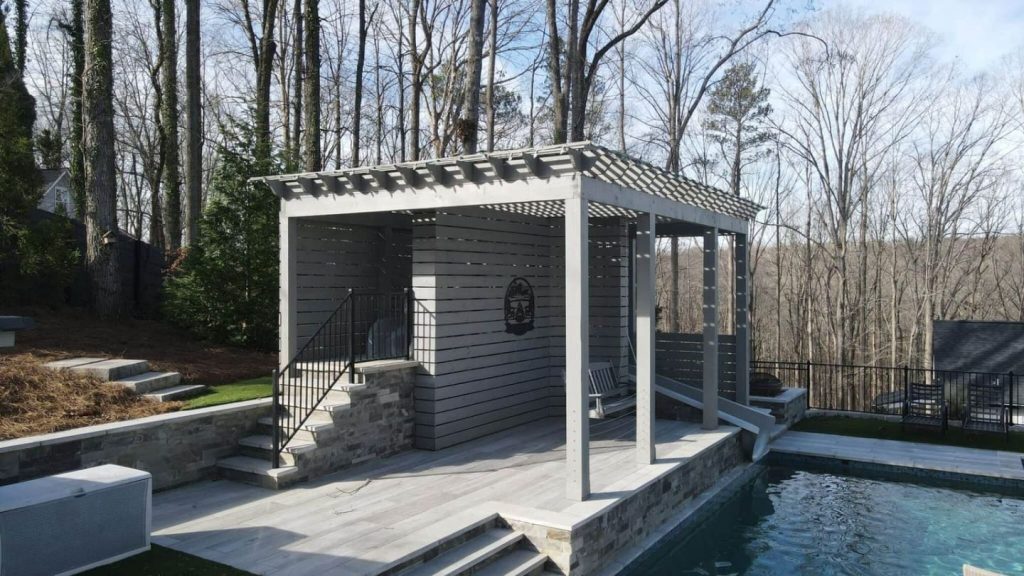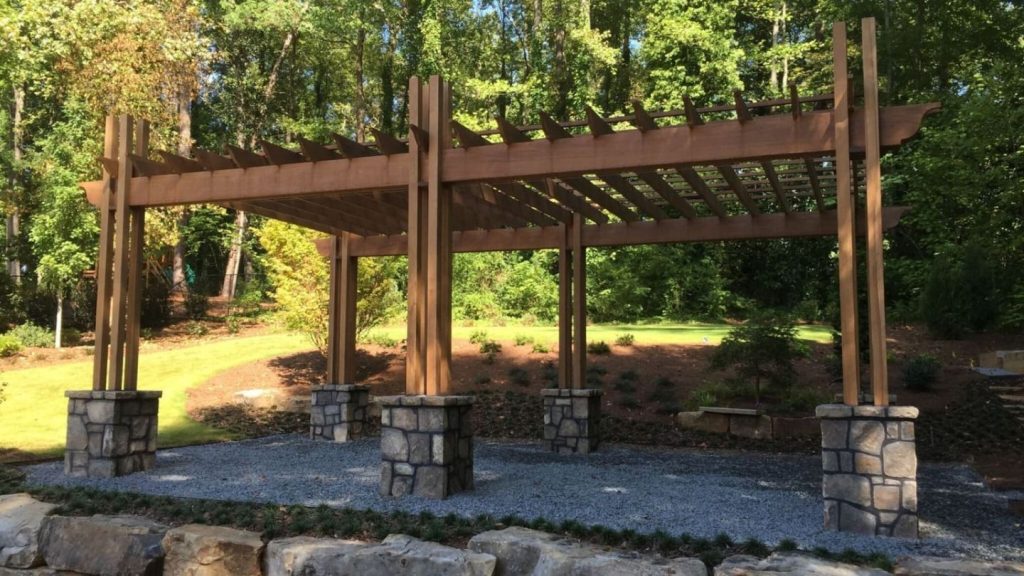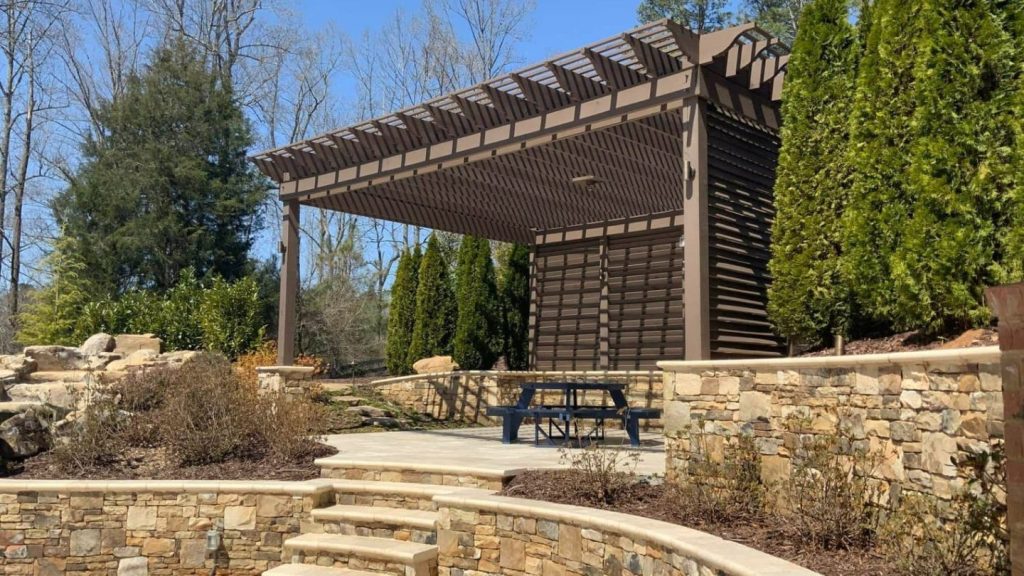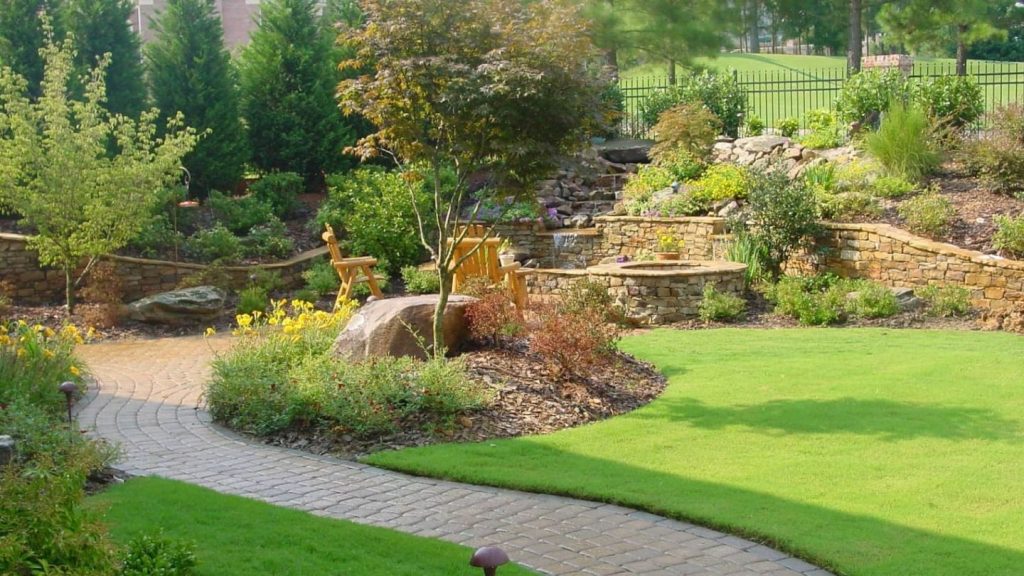Installing a pergola can transform your outdoor space, but understanding pergola installation mistakes is crucial to prevent costly and frustrating issues. In this article, we’ll discuss the top mistakes to avoid in pergola installation, helping you ensure a smooth and successful project.
Key Takeaways
- Choose high-quality materials suited to your local climate to ensure the durability and appearance of the pergola.
- Acquire necessary permits and adhere to local building codes to avoid legal issues and enhance property value. Follow specific guidelines during the pergola installation process to ensure a successful outcome and avoid common pitfalls.
- Maintain regular upkeep through cleaning and sealing to extend the lifespan and preserve the aesthetics of the pergola.
Planning and Design Mistakes
Planning and design mistakes can be costly and time-consuming to rectify. Here are some common mistakes to avoid:
- Insufficient Planning: One of the most common mistakes in pergola installation is failing to plan adequately. Without a clear vision of the pergola’s purpose, size, and location, you might end up with a structure that doesn’t meet your needs or fit well within your outdoor space. Take the time to outline your goals and requirements before starting the project.
- Poor Design: A poorly designed pergola can be both aesthetically unpleasing and functionally inadequate. Consider factors such as the pergola’s shape, style, and materials to ensure it complements your home and serves its intended purpose. A well-thought-out design enhances both the visual appeal and usability of your outdoor living space.
- Inadequate Consideration of Local Building Codes: Ignoring local building codes and regulations can lead to costly fines and penalties. It’s essential to research and adhere to these codes to avoid legal issues and ensure the safety and durability of your pergola. Consulting with local authorities or a professional can help you navigate these requirements.
- Ignoring Site Conditions: Site conditions such as drainage, wind direction, and soil stability play a crucial role in the success of your pergola installation. Failing to consider these factors can lead to structural problems and safety hazards. Conduct a thorough site assessment and make necessary adjustments to accommodate these conditions.
- Not Considering the Style and Architecture of Your Home: A pergola that doesn’t complement the style and architecture of your home can detract from its overall appearance. Choose a design that harmonizes with your home’s aesthetic to create a cohesive and visually appealing outdoor space.
To avoid these common mistakes, take the time to plan and design your pergola carefully. Consider factors such as the purpose of the pergola, its size and location, local building codes, site conditions, and the style and architecture of your home. Thoughtful planning and design will ensure a successful and satisfying pergola project.
Choosing the Wrong Materials

When installing pergolas, using materials like non-treated lumber or inferior metals might seem cost-effective but are prone to quick deterioration. For wooden pergolas, hardwoods, like spotted gum or ironbark, are excellent choices for their resilience and visual appeal. Metals like aluminum or steel are practical for low-maintenance needs.
Choosing the wrong materials can lead to structural issues and increased maintenance. It’s essential to select materials that suit your local climate and design preferences to ensure longevity and attractiveness. Investing in high-quality materials initially can save on future repairs and upkeep.
Ignoring Local Building Codes and Necessary Permits
Neglecting local building codes and permits can derail your new pergola project. Permits ensure compliance with zoning laws and safety standards. Without them, you risk fines and might have to dismantle your pergola. Permit requirements vary based on the structure’s size, placement, and purpose. Securing permits beforehand avoids legal issues and adds property value.
Start the permit process early and consult local authorities about building codes. Contact utility companies for information on buried service lines to prevent post-construction issues. This proactive approach ensures your pergola stands the test of time.
Poor Site Preparation

Proper site preparation is crucial for a pergola installation. Common mistakes include not clearing debris, working on uneven terrain, and lacking a solid foundation, which can lead to long-term issues.
Ensure the area is clean and level to prevent instability and enhance durability. A solid base distributes weight evenly, providing strength against environmental factors. Use stakes to mark the pergola’s footprint for precise placement and alignment. Check that the pergola won’t block desirable views to avoid regrettable layout choices. These steps help avoid common pitfalls and lay a secure groundwork for your outdoor feature.
Incorrect Measurements and Sizing

Accurate measurements are essential for constructing a pergola. Incorrect dimensions can result in wasted materials and a structure that doesn’t fit its designated space. Proper measurement ensures functionality and visual appeal.
Improper sizing can make a pergola dysfunctional and unattractive. It may not harmonize with your home or landscape if not measured carefully.
The pergola’s orientation affects comfort and usability by considering sunlight and weather conditions. Careful planning and precise measurements prevent common construction mistakes, creating a welcoming outdoor space.
Skipping Structural Support
Ensuring structural support during the pergola installation process is crucial for the safety and durability of a pergola. Neglecting this critical step may result in significant problems, particularly during extreme weather conditions. It’s vital to select materials that are durable enough to cope with the local climate and incorporate structural brackets to provide additional stability. Correct anchoring techniques are essential to prevent the structure from toppling over, thus maintaining its integrity.
For robust support, the footings must be dug at least one-quarter as deep as the height of the pergola itself. The use of post-base brackets serves to reinforce anchoring effectiveness considerably. By concentrating on fundamental structural supports, you can guarantee long-lasting durability and safeguard against potential instability or collapse.
Neglecting Maintenance

Ignoring pergola maintenance can reduce its lifespan. Regular cleaning, sealing, and staining protect it from weather damage.
Many homeowners think pergolas need no upkeep, but regular maintenance prevents minor issues from becoming major problems. Wooden pergolas should be stained annually and sealed every two to three years to protect against moisture and weather.
Routine care extends your pergola’s life and keeps it looking good. By staying on top of these tasks, you avoid common maintenance mistakes. If unsure, consult professional pergola installers for advice and to avoid costly errors.
Rushing the Installation Process
Installing pergolas should not be hurried, as haste can result in errors that may affect the structure’s durability and visual quality. It is essential to adhere strictly to the given guidelines and initiate the project when weather conditions are favorable—avoiding wind or rain. Misjudging the intricacy involved in setting up your outdoor space with a pergola might yield inferior enhancements.
To circumvent typical installation blunders due to inadequate expertise, it is frequently advised to employ skilled installers. A deliberate and paced strategy during the installation will foster an effective setup of your pergola while helping you steer clear of common mistakes associated with installing such structures.
Failing to Consider Sunlight and Weather Conditions

To maximize your pergola’s utility and comfort in outdoor spaces, consider sunlight exposure and weather patterns. Strategic placement ensures optimal use and integration with your surroundings.
An east-facing pergola is great for morning sun lovers, while a westward orientation is ideal for afternoon relaxation. In warmer regions, a north-facing setup offers consistent shade throughout the day. Adding climbers or vines enhances both visual interest and shading.
By considering these factors, you can create an inviting outdoor space that is both charming and functional under various conditions.
Not Incorporating Personal Style
Ensure your new pergola reflects your aesthetic while harmonizing with the surrounding area. A mismatched design can make the space feel disjointed. Choose a motif that complements your home’s architectural style to highlight your personal taste.
Use color palettes that blend with your residence and landscaping for a cohesive look. Transform the mood with appropriate lighting options like fairy lights or lanterns, and add weather-resistant draperies for sophistication and privacy.
Incorporating your style into the pergola design creates an outdoor space that not only looks appealing but also reflects your personality.
Summary
In conclusion, being aware of pergola installation mistakes to avoid can ensure your pergola project is a resounding success. From choosing the right materials to considering local building codes and from proper site preparation to incorporating personal style, each step plays a crucial role in the overall outcome.
At Georgia Outdoor Living, we offer comprehensive outdoor design and construction services to help you create the perfect pergola. Our team of professionals is ready to assist you in bringing your dream outdoor space to life. Contact us today to get started on your project.
Frequently Asked Questions
What happens if I don’t obtain the necessary permits for my pergola?
Not obtaining the necessary permits for your new pergola can result in significant fines and may necessitate the removal of the structure. Ensuring compliance with regulations is essential to avoid these complications.
How often should I maintain my pergola?
To ensure the longevity of your pergola, it is advisable to perform maintenance, such as cleaning, sealing, and staining, every two to three years. Consulting with professional pergola installers can also be beneficial, as they bring expertise that ensures compliance with building codes and helps prevent costly mistakes. This will help preserve its condition and appearance over time.
What are the best materials for a durable pergola?
Opting for hardwoods like spotted gum or ironbark, as well as metals such as aluminum or steel, is advisable when installing pergolas. This combination ensures not only the structure’s durability but also minimizes maintenance demands for your durable pergola.
How do I ensure my pergola complements my home’s style?
To make your new pergola a natural extension of your home, select a design that matches the exterior style of your house and use color schemes that integrate seamlessly. Adding elements like outdoor lighting and textiles can also elevate the overall sense of unity.



